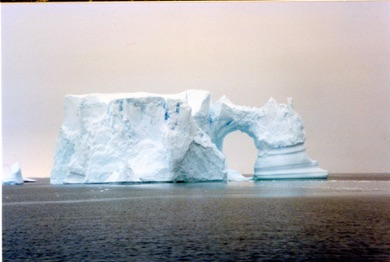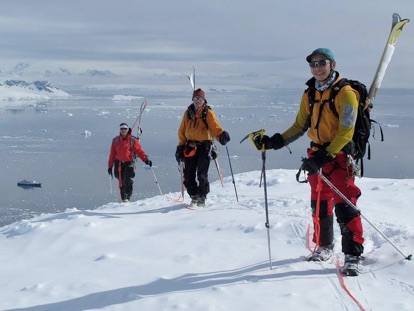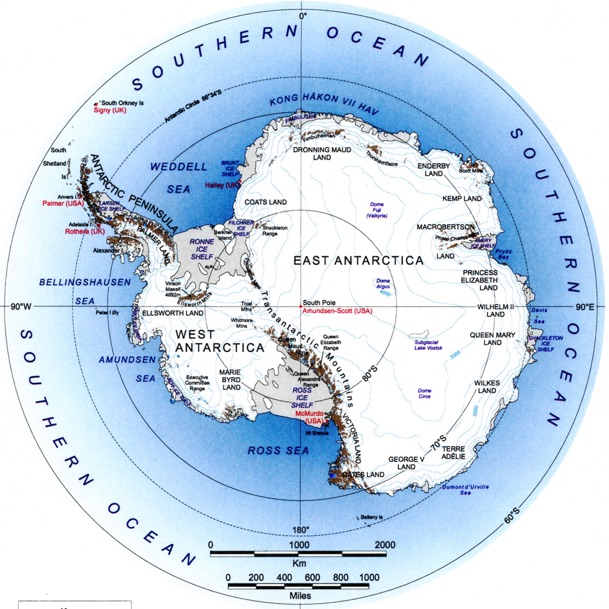Antarctica



There is something compelling in this white continent with its azure-blue waters, penguins, seals, and the vast vistas of ice and snow everywhere. It is an indelible experience to sail and view this vast and desolate landscape with its huge icebergs and vast glaciers, and to savor and enjoy the quietness of the surroundings, where nature reigns supreme.

right: A huge iceberg with a beautifully formed portal on the side. Remember that 90 % of the iceberg is under water.
It is also a continent in itself and if you want to be able to say that you have visited all 7 continents in the world, i.e., North America, South America, Africa, Europe, Asia, Australia, and Antarctica, then you obviously have to visit Antarctica. You can visit this region in an expedition-style ship, which allows you to board a Zodiac inflatable to land on some of the islands; you can also sail on a large, more stable traditional cruise ship and look at the panorama from a distance. Or, you can also sail there in your own private yacht. We have seen private yachts there.
If you go with a traditional cruise ship, you will probably not land at the uninhabited islands, because a wet landing would be required, and the fragile ecosystem is not able to handle the trampling of many uncivilized feet. You can still land at the research stations which now have thriving tourist shops with stuff to show you have been there. As you know, tourist shops can always be found in the footsteps of the tourist. The most well-known tourist shop in Antarctica is the one in Port Lockroy, belonging to Great Britain. There you will also get to wade through hundreds of Gentoo penguins and you will find that the smelly droppings, especially unpleasant in the summer, require some effort to remove from your shoes. Note that if this is the only landing you made in your tour, then you have technically not set foot on the Antarctica Continent, because Port Lockroy is on Goudier Island and not on the mainland.
Then there is the Ukrainian Research-station Vernadsky Point, which is the southernmost souvenir shop on earth, it is quite small. Technically there is still one further south, which is the one in the Amundsen-Scott station right on the South Pole, run by the USA.

left: You can also go skiing in Antarctica, if you so desire. It is not inexpensive, and there are no ski lifts, so you have to slog up the mountains before you can ski downhill in this most unusual and beautiful surroundings. In front is Launce Gouw, in professional life an oncologist specialist in lymphoma, who has skied in over 100 different locations all over the world. This picture was taken in 2013.
As you can see, Antarctica is now not anymore just a destination to visit for the views. For the more adventurous, you can find a commercial company who will take you to Antarctica to go skiing, mountain climbing, emperor penguin watching, and other interesting and I am pretty sure very tiring activities.

Above: Map of the Antarctic Continent issued by the US Geological Survey. The Antarctic Peninsula is just a small appendix to the large continent. The area where the commercial Antarctica tours go is just that minuscule region to the left of the letters ANT of the Antarctica Peninsula.
Antarctica is also the coldest, windiest, and driest continent of the seven. It has an area of 5.4 million square miles; it is larger than that of the United States, where the size of the landmass is around 3.6 million square miles. The Antarctic continent is divided in two unequal parts, the much larger East Antarctica and the smaller West Antarctica. From West Antarctica a peninsula jots out to the West of the mainland, with many small islands around it. This part is called the Antarctic Peninsula, which is closest to South America and hence the destination of choice of most touring vessels visiting the continent.
With all the ice around, the region is surprisingly classified as a desert. There is very little precipitation, an average of 2 inches in the form of snow, each year. The coldest temperature in the world, -129.3 deg F was recorded here.
Most people imagine the presence of huskies to assist travelers in this ice wilderness. After all, they are used everywhere in Alaska and in the Arctic circle. They were used by the earlier explorers, such as Roald Amundsen and Robert Scott in their race to get to the South Pole first. But as of 1994, no non-native species are allowed into Antarctica. Hence there are now no more huskies here to act as sled dogs. In this barren land motor-powered vehicles are currently the transportation mode of choice. I surmise motorized vehicles are now classified as native species there.
Inextricably connected to this area is the saga of the two groups of explorers who had set out at about the same time to be the first to reach the South Pole. The victors were under the command of the Norwegian explorer Roald Amundsen. Using skis and dog sleds it took him and his other 4 men less than 2 months to complete the journey, arriving at the Pole on December 14, 1911. In his journal he ascribes his success to painstaking preparation and his ability to foresee and to avoid potential problems, implying that the tragedy of the Scott expedition was due to poor planning.
The other party was led by the explorer Robert Scott who, leading a party of five, arrived at the pole 4 weeks later; happy to have reached their destination, but completely disheartened because they had lost the race. Going back home, they encountered very bad weather and perished in their sleeping bags in a small tent out on the ice, just 11 miles from the nearest cache of food and supplies they had left there earlier on their journey out.
But times move relentlessly forward. What used to be the desolate spot, there is now a large research station on the spot of the South Pole, aptly named the Amundsen-Scott station. I have been told that there is even a tourist shop in that building. !!


